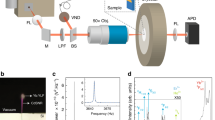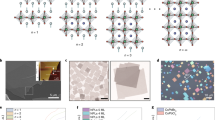Abstract
Optical irradiation with suitable energy can cool solids, a phenomenon known as optical refrigeration, first proposed in 1929 and experimentally achieved in ytterbium-doped glasses in 1995. Since then, considerable progress has been made in various rare earth element-doped materials, with a recent record of cooling to 91 K directly from ambient temperatures. For practical use and to suit future applications of optical refrigeration, the discovery of materials with facile and scalable synthesis and high cooling power density will be required. Herein we present the realization of a net cooling of 23.0 K in micrometre-thick 3D CH3NH3PbI3 (MAPbI3) and 58.7 K in exfoliated 2D (C6H5C2H4NH3)2PbI4 (PhEPbI4) perovskite crystals directly from room temperature. We found that the perovskite crystals exhibit strong photoluminescence upconversion and near unity external quantum efficiency, properties that are responsible for the realization of net laser cooling. Our findings indicate that solution-processed perovskite thin films may be a highly suitable candidate for constructing integrated optical cooler devices.
This is a preview of subscription content, access via your institution
Access options
Subscribe to this journal
Receive 12 print issues and online access
$209.00 per year
only $17.42 per issue
Buy this article
- Purchase on Springer Link
- Instant access to full article PDF
Prices may be subject to local taxes which are calculated during checkout






Similar content being viewed by others
References
Pringsheim, P. Zwei bemerkungen über den unterschied von lumineszenz- und temperaturestrahlung. Z. Phys. A 57, 739–746 (1929).
Epstein, R. I., Buchwald, M. I., Edwards, B. C., Gosnell, T. R. & Mungan, C. E. Observation of laser-induced fluorescent cooling of solid. Nature 377, 500–503 (1995).
Gosnell, T. R. Laser cooling of a solid by 65K starting from room temperature. Opt. Lett. 24, 1041–1043 (1999).
Melgaard, S., Seletskiy, D., Albrecht, A. & Sheik-Bahae, M. First solid-state cooling below 100K. SPIE Newsroom (13 March 2015).
Seletskiy, D. V. et al. Laser cooling of solids to cryogenic temperatures. Nature Photon. 4, 161–164 (2010).
Seletskiy, D. V. et al. Local laser cooling of Yb:YLF to 110 K. Opt. Express 19, 18229–18236 (2011).
Gauck, H., Gfroerer, T. H., Renn, M. J., Cornell, E. A. & Bertness, K. A. External radiative quantum efficiency of 96% from a GaAs/GaInP heterostructure. Appl. Phys. A 64, 143–147 (1997).
Sheik-Bahae, M. & Epstein, R. I. Can laser light cool semiconductors? Phys. Rev. Lett. 92, 247403 (2004).
Sheik-Bahae, M. & Epstein, R. I. Optical refrigeration. Nature Photon. 1, 693–699 (2007).
Zhang, J., Li, D., Chen, R. & Xiong, Q. H. Laser cooling of a semiconductor by 40 Kelvin. Nature 493, 504–508 (2013).
Burschka, J. et al. Sequential deposition as a route to high-performance perovskite-sensitized solar cells. Nature 499, 316–319 (2013).
Lee, M. M., Teuscher, J., Miyasaka, T., Murakami, T. N. & Snaith, H. J. Efficient hybrid solar cells based on meso-superstructured organometal halide perovskites. Science 338, 643–647 (2012).
Stranks, S. D. et al. Electron-hole diffusion lengths exceeding 1 micrometer in an organometal trihalide perovskite absorber. Science 342, 341–344 (2013).
Xing, G. et al. Long-range balanced electron- and hole-transport lengths in organic-inorganic CH3NH3PbI3 . Science 342, 344–347 (2013).
Xing, G. et al. Low-temperature solution-processed wavelength-tunable perovskites for lasing. Nature Mater. 13, 476–480 (2014).
Zhang, Q., Ha, S. T., Liu, X. F., Sum, T. C. & Xiong, Q. H. Room-temperature near-infrared high-q perovskite whispering-gallery planar nanolasers. Nano Lett. 14, 5995–6001 (2014).
Xing, J. et al. Vapor phase synthesis of organometal halide perovskite nanowires for tunable room-temperature nanolasers. Nano Lett. 15, 4571–4577 (2015).
Dong, Q. et al. Solar cells. Electron-hole diffusion lengths >175 μm in solution-grown CH3NH3PbI3 single crystals. Science 347, 967–970 (2015).
Shi, D. et al. Solar cells. Low trap-state density and long carrier diffusion in organolead trihalide perovskite single crystals. Science 347, 519–522 (2015).
Wehrenfennig, C., Eperon, G. E., Johnston, M. B., Snaith, H. J. & Herz, L. M. High charge carrier mobilities and lifetimes in organolead trihalide perovskites. Adv. Mater. 26, 1584–1589 (2014).
Ha, S. T. et al. Synthesis of organic-inorganic lead halide perovskite nanoplatelets: Towards high performance perovskite solar cells and opto-electronic devices. Adv. Opt. Mater. 2, 838–844 (2014).
Baikie, T. et al. Synthesis and crystal chemistry of the hybrid perovskite (CH3NH3)PbI3 for solid-state sensitised solar cell applications. J. Mater. Chem. A 1, 5628–5641 (2013).
Roosbroeck, W. V. & Shockley, W. Photon-radiative recombination of electrons and holes in germanium. Phys. Rev. 94, ( 1954).
Mosconi, E., Amat, A., Nazeeruddin, M. K., Grätzel, M. & De Angelis, F. First-principles modeling of mixed halide organometal perovskites for photovoltaic applications. J. Phys. Chem. C 117, 13902–13913 (2013).
Stoumpos, C. C., Malliakas, C. D. & Kanatzidis, M. G. Semiconducting tin and lead iodide perovskites with organic cations: phase transitions, high mobilities, and near-infrared photoluminescent properties. Inorg. Chem. 52, 9019–9038 (2013).
Kitazawa, N. & Watanabe, Y. Optical properties of natural quantum-well compounds (C6H5-CnH2n-NH3)2PbBr4 (n=1–4). J. Phys. Chem. Solids 71, 797–802 (2010).
Lanty, G. et al. Room-temperature optical tunability and inhomogeneous broadening in 2D-layered organic-inorganic perovskite pseudobinary alloys. J. Phys. Chem. Lett. 5, 3958–3963 (2014).
Imangholi, B. et al. Differential luminescence thermometry in semiconductor laser cooling. Proc. SPIE 6115, 61151C (2006).
Chen, R. et al. Excitonic properties and near-infrared coherent random lasing in vertically aligned CdSe nanowires. Adv. Mater. 23, 1404–1408 (2011).
Utama, M. I. et al. Vertically aligned cadmium chalcogenide nanowire arrays on muscovite mica: a demonstration of epitaxial growth strategy. Nano Lett. 11, 3051–3057 (2011).
Gray, A. S. & Uher, C. Thermal conductivity of mica at low temperatures. J. Mater. Sci. 12, 959–965 (1977).
Pisoni, A. et al. Ultra-low thermal conductivity in organic-inorganic hybrid perovskite CH3NH3PbI3 . J Phys Chem Lett 5, 2488–2492 (2014).
Li, D., Zhang, J., Wang, X., Huang, B. & Xiong, Q. H. Solid-state semiconductor optical cryocooler based on CdS nanobelts. Nano Lett. 14, 4724–4728 (2014).
Khurgin, J. B. Band gap engineering for laser cooling of semiconductors. J. Appl. Phys. 100, 113116 (2006).
Khurgin, J. B. Surface plasmon-assisted laser cooling of solids. Phys. Rev. Lett. 98, 177401 (2007).
Khurgin, J. B. Role of bandtail states in laser cooling of semiconductors. Phys. Rev. B 77, 235206 (2008).
Rupper, G., Kwong, N. H. & Binder, R. Large excitonic enhancement of optical refrigeration in semiconductors. Phys. Rev. Lett. 97, 117401 (2006).
Wang, C. G., Li, C. Y., Hasselbeck, M. P., Imangholi, B. & Sheik-Bahae, M. Precision, all-optical measurement of external quantum efficiency in semiconductors. J. Appl. Phys. 109, 093108 (2011).
Acknowledgements
Q.X. gratefully acknowledges the strong support of this work from Singapore National Research Foundation through an Investigatorship Award (NRF-NRFI2015–03), Ministry of Education via two AcRF Tier 2 grants (MOE2013-T2-1-049 and MOE2015-T2-1-047) and Tier1 grant (2013-T1-002-232). This work was also supported in part by AFOSR through its Asian Office of Aerospace Research and Development (FA2386-13-1-4112).
Author information
Authors and Affiliations
Contributions
S.T.H. and Q.X. conceived the idea; S.T.H., C.S., J.Z., and Q.X. designed the experiments; S.T.H. and C.S. performed the experiments; S.T.H., C.S., J.Z., and Q.X. analysed the data and wrote the manuscript.
Corresponding author
Ethics declarations
Competing interests
The authors declare no competing financial interests.
Supplementary information
Supplementary information
Supplementary information (PDF 6325 kb)
Rights and permissions
About this article
Cite this article
Ha, ST., Shen, C., Zhang, J. et al. Laser cooling of organic–inorganic lead halide perovskites. Nature Photon 10, 115–121 (2016). https://doi.org/10.1038/nphoton.2015.243
Received:
Accepted:
Published:
Issue Date:
DOI: https://doi.org/10.1038/nphoton.2015.243
This article is cited by
-
Characteristics investigation of Yb3+:YAG crystals for optical refrigeration
Frontiers of Physics (2023)
-
Dual-resonance enhanced quantum light-matter interactions in deterministically coupled quantum-dot-micropillars
Light: Science & Applications (2021)
-
Recent advances and perspective on the synthesis and photocatalytic application of metal halide perovskite nanocrystals
Nano Research (2021)
-
Space-confined growth of metal halide perovskite crystal films
Nano Research (2021)
-
Growth of centimeter-scale perovskite single-crystalline thin film via surface engineering
Nano Convergence (2020)



